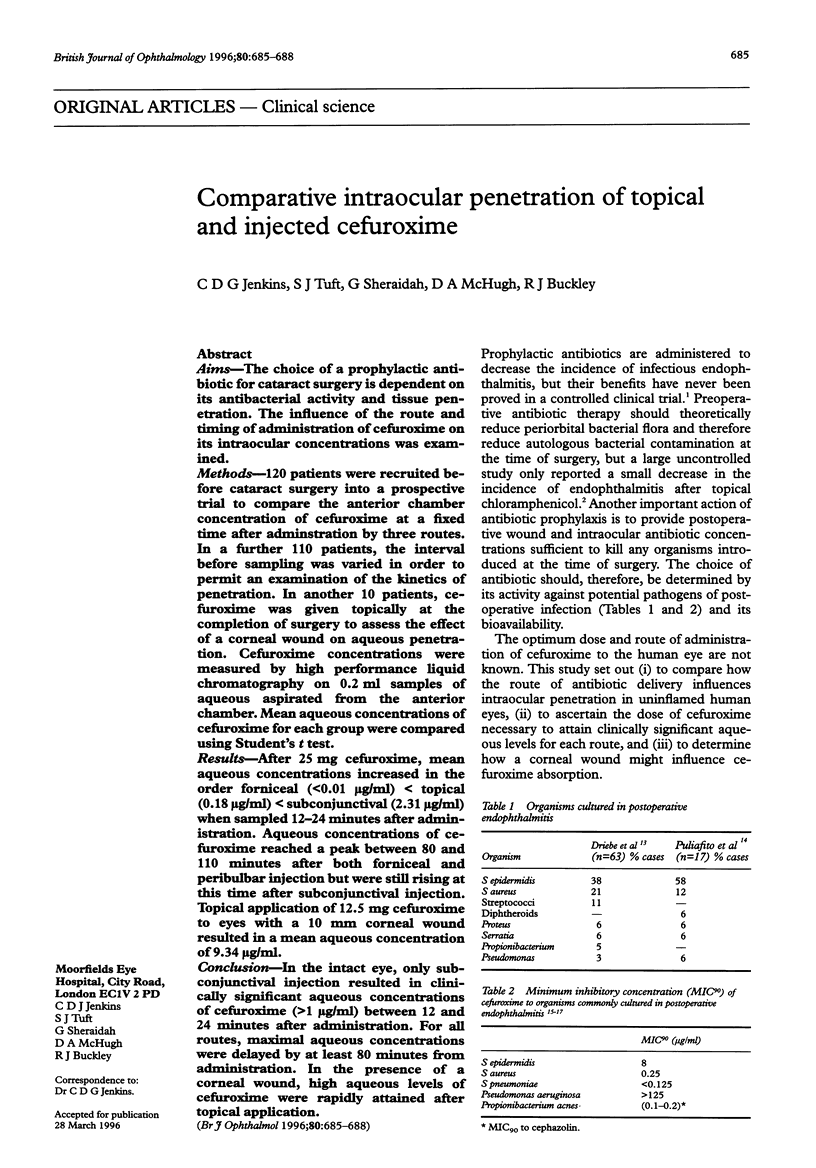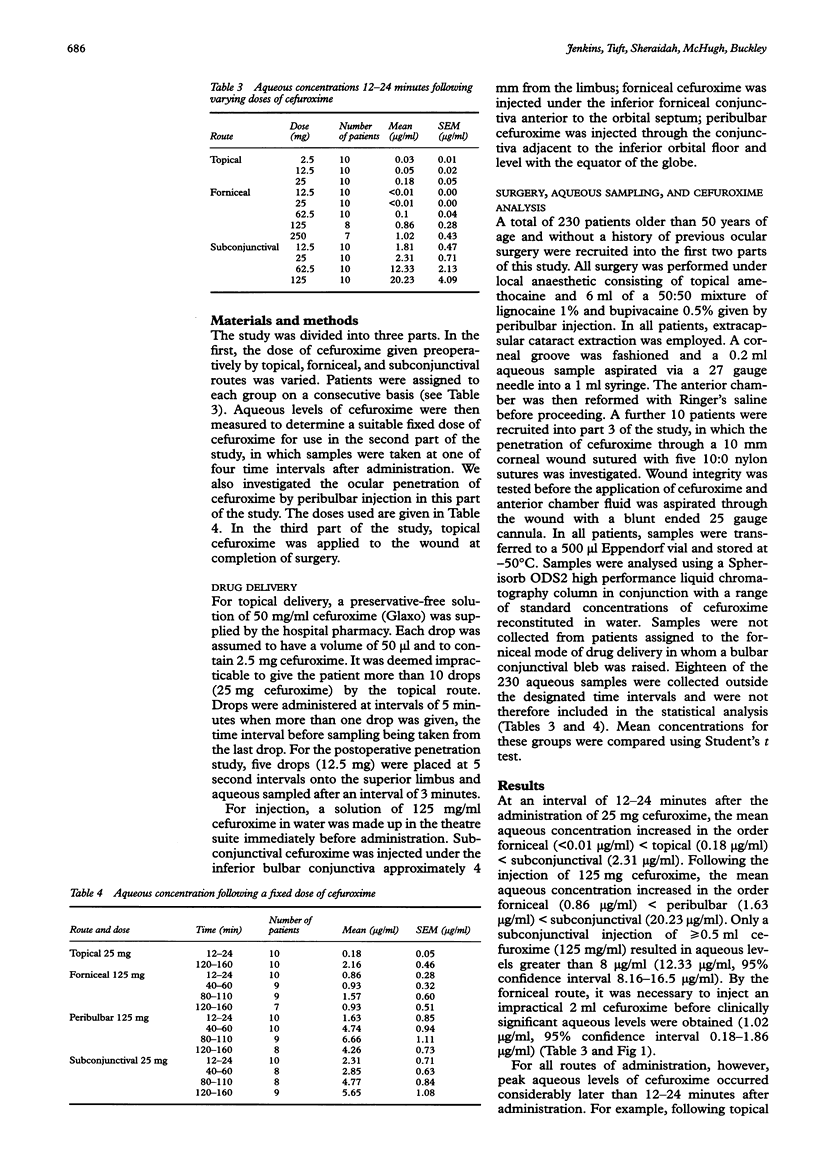Abstract
AIMS: The choice of a prophylactic antibiotic for cataract surgery is dependent on its antibacterial activity and tissue penetration. The influence of the route and timing of administration of cefuroxime on its intraocular concentrations was examined. METHODS: 120 patients were recruited before cataract surgery into a prospective trial to compare the anterior chamber concentration of cefuroxime at a fixed time after administration by three routes. In a further 110 patients, the interval before sampling was varied in order to permit an examination of the kinetics of penetration. In another 10 patients, cefuroxime was given topically at the completion of surgery to assess the effect of a corneal wound on aqueous penetration. Cefuroxime concentrations were measured by high performance liquid chromatography on 0.2 ml samples of aqueous aspirated from the anterior chamber. Mean aqueous concentrations of cefuroxime for each group were compared using Student's t test. RESULTS: After 25 mg cefuroxime, mean aqueous concentrations increased in the order forniceal (< 0.1 microgram/ml) < topical (0.18 microgram/ml) < subconjunctival (2.31 microgram/ml) when sampled 12-24 minutes after administration. Aqueous concentrations of cefuroxime reached a peak between 80 and 110 minutes after both forniceal and peribulbar injection but were still rising at this time after subconjunctival injection. Topical application of 12.5 mg cefuroxime to eyes with a 10 mm corneal wound resulted in a mean aqueous concentration of 9.34 micrograms/ml. CONCLUSION: In the intact eye, only sub-conjunctival injection resulted in clinically significant aqueous concentrations of cefuroxime (> 1 microgram/ml) between 12 and 24 minutes after administration. For all routes, maximal aqueous concentrations were delayed by at least 80 minutes from administration. In the presence of a corneal wound, high aqueous levels of cefuroxime were rapidly attained after topical application.
Full text
PDF



Selected References
These references are in PubMed. This may not be the complete list of references from this article.
- Allen H. F., Mangiaracine A. B. Bacterial endophthalmitis after cataract extraction. II. Incidence in 36,000 consecutive operations with special reference to preoperative topical antibiotics. Arch Ophthalmol. 1974 Jan;91(1):3–7. doi: 10.1001/archopht.1974.03900060007002. [DOI] [PubMed] [Google Scholar]
- Axelrod J. L., Kochman R. S. Cefoxitin levels in human aqueous humor. Am J Ophthalmol. 1980 Sep;90(3):388–393. doi: 10.1016/s0002-9394(14)74923-2. [DOI] [PubMed] [Google Scholar]
- Christy N. E., Lall P. Postoperative endophthalmitis following cataract surgery. Effects on subconjunctival antibiotics and other factrs. Arch Ophthalmol. 1973 Nov;90(5):361–366. doi: 10.1001/archopht.1973.01000050363005. [DOI] [PubMed] [Google Scholar]
- Clements D. B., Tailor V. A study of aqueous and serum levels of ceftazidime following subconjunctival administration. Br J Ophthalmol. 1987 Jun;71(6):433–435. doi: 10.1136/bjo.71.6.433. [DOI] [PMC free article] [PubMed] [Google Scholar]
- Driebe W. T., Jr, Mandelbaum S., Forster R. K., Schwartz L. K., Culbertson W. W. Pseudophakic endophthalmitis. Diagnosis and management. Ophthalmology. 1986 Apr;93(4):442–448. doi: 10.1016/s0161-6420(86)33722-9. [DOI] [PubMed] [Google Scholar]
- Eykyn S., Jenkins C., King A., Phillips I. Antibacterial activity of cefuroxime, a new cephalosporin antibiotic, compared with that of cephaloridine, cephalothin, and cefamandole. Antimicrob Agents Chemother. 1976 Apr;9(4):690–695. doi: 10.1128/aac.9.4.690. [DOI] [PMC free article] [PubMed] [Google Scholar]
- Jenkins C. D., McDonnell P. J., Spalton D. J. Randomised single blind trial to compare the toxicity of subconjunctival gentamicin and cefuroxime in cataract surgery. Br J Ophthalmol. 1990 Dec;74(12):734–738. doi: 10.1136/bjo.74.12.734. [DOI] [PMC free article] [PubMed] [Google Scholar]
- Koul S., Philipson A., Philipson B. T., Kock E., Nylén P. Intraocular levels of cefuroxime in uninflamed rabbit eyes. Acta Ophthalmol (Copenh) 1990 Aug;68(4):455–465. doi: 10.1111/j.1755-3768.1990.tb01676.x. [DOI] [PubMed] [Google Scholar]
- McGhee C. N., Noble M. J., Watson D. G., Dutton G. N., Fern A. I., Healey T. M., Midgley J. M. Penetration of topically applied prednisolone sodium phosphate into human aqueous humour. Eye (Lond) 1989;3(Pt 4):463–467. doi: 10.1038/eye.1989.69. [DOI] [PubMed] [Google Scholar]
- Oakley D. E., Weeks R. D., Ellis P. P. Corneal distribution of subconjunctival antibiotics. Am J Ophthalmol. 1976 Mar;81(3):307–312. doi: 10.1016/0002-9394(76)90245-2. [DOI] [PubMed] [Google Scholar]
- Puliafito C. A., Baker A. S., Haaf J., Foster C. S. Infectious endophthalmitis. Review of 36 cases. Ophthalmology. 1982 Aug;89(8):921–929. [PubMed] [Google Scholar]
- Saunders J. H., McPherson S. D., Jr Ocular penetration of cefazolin in humans and rabbits after subconjunctival injection. Am J Ophthalmol. 1980 Apr;89(4):564–566. doi: 10.1016/0002-9394(80)90067-7. [DOI] [PubMed] [Google Scholar]
- Starr M. B. Prophylactic antibiotics for ophthalmic surgery. Surv Ophthalmol. 1983 May-Jun;27(6):353–373. doi: 10.1016/0039-6257(83)90193-5. [DOI] [PubMed] [Google Scholar]
- Wang W. L., Everett E. D., Johnson M., Dean E. Susceptibility of Propionibacterium acnes to seventeen antibiotics. Antimicrob Agents Chemother. 1977 Jan;11(1):171–173. doi: 10.1128/aac.11.1.171. [DOI] [PMC free article] [PubMed] [Google Scholar]


